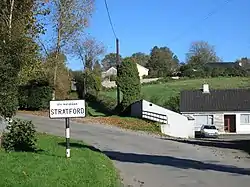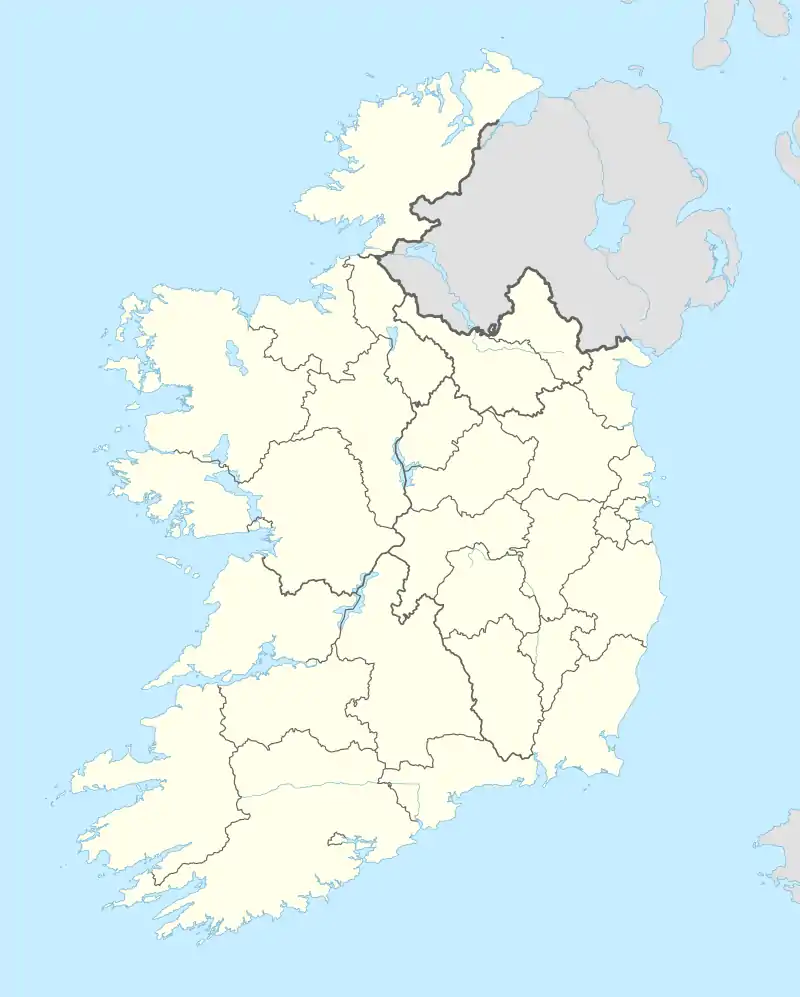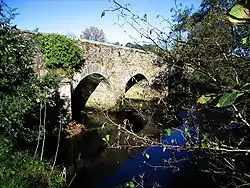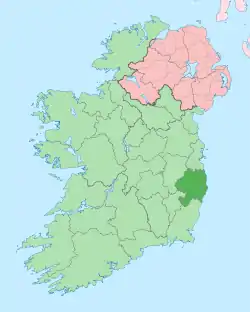Stratford-on-Slaney
Stratford-on-Slaney (Irish: Áth na Sráide, meaning "ford of the street"), also known as Stratford or Stratford-upon-Slaney, is a small village on the River Slaney in west County Wicklow in Ireland. According to the latest census, conducted in 2016, the village then had a population of 241.[1]
Stratford-on-Slaney
Áth na Sráide | |
|---|---|
Village | |
 Signage on the approach to the village | |
 Stratford-on-Slaney Location in Ireland | |
| Coordinates: 52°59′18″N 6°40′06″W | |
| Country | Ireland |
| Province | Leinster |
| County | County Wicklow |
| Elevation | 183 m (600 ft) |
| Population (2016)[1] | |
| • Urban | 241 |
| Time zone | UTC+0 (WET) |
| • Summer (DST) | UTC-1 (IST (WEST)) |
| Irish Grid Reference | S890937 |
History

Stratford-on-Slaney is a small town with a big industrial history and it played a very strategic and documented role in the cotton/linen industry of Ireland in the 18th and 19th centuries.
According to Lewis 1837, Stratford-upon-Slaney was a market town in the barony of Upper Talbotstown 2¼ miles NNE from Baltinglass. At that time the town contained 2,833 inhabitants. Edward the 2nd Earl of Aldborough, who built this town gave it his family name Stratford. It is built on the summit of a hill raising up from the river Slaney.
There were extensive cotton and calico printing works established in Stratford-on-Slaney in 1792 and in 1837 the owners of this facility were Orr and Co. who bought the factory from the Stratford family. It employed about 1,000 people and turned out about 2,000 finished pieces per week.
The infrastructural buildings erected by Aldborough in the town included a glebe house, several dwelling houses, a Roman Catholic Chapel, a Meeting House for the Presbyterians of the Synod of Ulster and an Anglican church called St John the Baptist's which was based on Gibbsian architecture according to Lightbrown. The first fever hospital in Wicklow was built here in 1817 and there was a town dispensary which contained 24 beds. The castle which is on the 1800s maps was also refurbished by Aldborough.
In the early 1800s according to Millennium Memories the town was lively and bustling with the linen and printing works. In the village there were twelve streets, containing 108 houses, four squares, Winetavern Street, Church Road and the Octagon. There were at least thirteen public houses.
According to Millennium Memories, the famine and the deadly fever in 1847 had a very negative impact on this prosperous town. Many if not all of the emigrant workers returned to their native places of Paisley in Scotland and Hillsborough Co. Down. The mill sold for the last time in 1852 and "by the mid 1960s, Stratford stood bare, with the exception of a dozen or so houses and the ruins of what once was one man's dream" namely the 2nd Earl of Aldborough.
Earl of Aldborough
The 2nd Earl of Aldborough was also called Edward Stratford and The Viscount Amiens, he built "Aldborough House" in Dublin's Portland Row. Statford Row, Aldborough Place and Amiens Street in Dublin all derive their names from this man (Moloney 2014). Aldborough House is now derelict though several of the features remain. According to Archiseek, it was completed in 1798 and it included a music room and a playhouse. "It is built of brick and cut granite and at one stage had a balustrade all the way around the parapets, with urns, eagles, sphinxes, lions and coats of arms." According to the 'Aesthete' website, "Lord Aldborough failed to take into account the consequences of the 1800 Act of Union which led to a decline in the city’s fortunes and left his great town house stranded". Some of it was built by the architect Richard Johnston and it was according to Archiseek the last great mansion to be erected in the city before the 1800 Act of Union in 1800, when Dublin ceased to be the second city of the Empire.
The Earl was one of the ten wealthiest men in Ireland according to Lightbrown, he built the town of Stratford-on-Slaney from 1774 onwards on the Manor of Manger. At the time of building Stratford-on-Slaney he was also building Stratford Place, off Oxford Street, which was one of the finest small developments of late Georgian London and is still mainly intact. His main purpose for this town was to attract the textile industry to this area. This town was to be modelled on the "fashionable resort" of Bath in England. The Earl built housing and laid on water and other necessary infrastructure in the town.
Aldborough also continued to improve and established several industries at the main estate house in Belan, Co. Kildare which was built in 1709. This demesne included several feature bridges over the Barrow river and at one stage incorporated exotic fish in man built ponds and lakes. The house also had its own theatre and an extensive library.
According to Fraser, Stratford Lodge where Baltinglass Golf Club is now situated was a seat of the Aldborough Family and in this demesne there were school houses, a hotel, plantations and other improvements associated with a demesne. "The last Lord Aldborough Benjamin O'Neill died unmarried in Spain in 1875. He had spent his time in Baltinglass experimenting with Balooning". (Information Boards, Baltinglass Library).
Mill owners (Orr family)
The Aldborough Family sold the Stratford-on-Slaney enterprise to Mr. Orr. The company which owned the manufacturing facility was called Smith Orrs’ & Sons with a Dublin address of 8 Merchants Quay and it was in operation in this name between 1782 and 1795 (Langfield 1945).
After protections were imposed by the independent Irish parliament on the import of cotton goods, W & J Orr instead of importing cotton goods started to manufacture in Ireland. It established a base for weaving and bleaching muslins at Hillsborough near Belfast. In the early 1790s it added calico weaving and printing at Stratford-on-Slaney and by 1796 it was employing 3,000 people between Hillsborough, Dublin and Stratford. The Orrs’ had a manufacturing profile in Scotland as well. They eventually ceased muslin production in the north of Ireland and concentrated on calico weaving, bleaching and printing in Wicklow importing their yarn from Britain and buying a significant amount of their stock from the north as brown cloth (Nisbet & Foster 2008).
Between the 1740s and 1770s a small colony of Scottish merchants established itself in Dublin importing "Scotch" textile goods. These firms included Barbour & Duncan, Barbour & Howie, William Bayne, Gemmill, Smith and others which were based in Bridge Street, Ushers Quay and Merchants Quay. A lot came from the Paisley area of Scotland. They wanted to secure the luxury market. Ireland at this time was the 2nd largest city of the Empire. Grants after 1782 were available to factories located more than ten miles outside Dublin. Machines used were ‘jennies’ but by 1783 a grant was made towards the construction of an Arkwright water twist mill. In general grants were made to partnerships between landlords and merchant manufacturers. By 1785 quality of Irish output was sufficiently high for Irish printed cottons to be successfully exported to Portugal and Latin America. The Orrs’ bought the established factory village at Stratford-on-Slaney in 1791 and said that it would cost £20,000 to develop it as a weaving, bleaching and printing centre. They formed a partnership probably with Archibald Smith of Merchants Quay in 1791. The advertisement at the time says that the Earl's venture consisted of: 36 new stone and slated houses, 1 partially built school, 14 roomed mansion, Bleachfield and bleaching house, Factory for printing linens, Mill, and Dyehouses.
By the end of the 1790s the Orrs had got a good foothold on the Irish cotton/calico industry. The production of muslins and calico printing provided them with high-value end products which went directly to the retail market and produced larger profits than inputs such as yarn or brown cloth. The works were reportedly sold into the ownership of John Swainson a Preston cotton merchant around 1837. The Orrs continued their business in Scotland (Nisbet and Foster 2008).
The Stratford-on-Slaney enterprise was in business for about 50 years and according to Atkinson a complete labour force was brought over from Scotland to and Northern Ireland to work in the factory at Stratford-on-Slaney.
Making calico
The Hanbidge name was popular in the Stratford-on-Slaney district as evidenced by the many headstones of this name now in the St. John the Baptist Church graveyard. William Hanbidge has written a memoir which describes in interesting detail, some of the stages of calico and linen production from flax grown in this district in the 1800s. Hanbidge said that flax was sown in Springtime and "in due time was pulled up and tied in sheaves and carted off to the 'blind arch' of Kelsha Bride" (Kelsha and Gibstown were bridges over the Slaney and the 'blind arch' was an arch over a very deep pool separated from the river). "The flax was put under water ('bogged' they called it) to help to separate the fibre from the stalk. After a few weeks it was taken up and carted back and spread on the new mown meadow to dry". "When it was dry it was tied up into large (now) white bundles and put up in safe place till winter when it was dried on a hurdle over a fire broke with a brake, skutched, carded or hackled".
Broke with a brake: the stalks of the flax were crushed with the proper tool Skutched: the seeds were beaten out, I suppose with a flail. The same word was used for the separation of grains of corn from the husk. Carded: "a thin wooden board with a handle attached was pierced with steel wire, as fine as a fine sewing needle. The wire was fastened to the back and cut at the top so that the board was studded with tiny points, or hackles, of sharp wire each about a quarter of an inch long, arranged in rows. The flattened stalks of the flax were drawn backwards and forwards over the points till the fibres were combed out, thin and straight. The board was about one and a half foot square or sometimes only the size of an octavo book". One could earn a living carding for others. The flax would then be spun which was music to the ears. A pound of flax was spun into hanks of yarn each twelve cuts containing 120 threads which were sent then on to be woven into linen. Out of the tow of the flax, yarn was spun to make table cloths, linsey linen (a coarse fabric), sheets etc., Some of the coarse material was used for sacks to hold 40 stone of potatoes.
A family could have everything they wore manufactured and this included coats of wool, stockings of flannel and other attire in linsey linen. The threads would be sent to Jack Flynn to be woven and then to the dyers in Donard who before dying it sent it to the tuck mill where the weave would be improved.
"On the cross road from Kelsha Hill to Davidstown Chapel there was a little hamlet of about twenty families, a small colony of weavers who wove blankets and linen for the countryside".
Mary Ann Hanbidge
Mary Ann Hanbidge lived in Tinnahinch House, (the house of the river meadow) "which stood far back from the road down Kelsha Hill". According to Mary Ann Hanbidge her cousins told her in 1938, that on a "May day, very early in the morning, farmers would plant twigs of the quicken tree (the mountain ash), all about their pastures to keep the witches 'the bad people' from casting a spell on their cows so that they gave no milk during the year". "On May Day also it was unlucky to give or lend anything whatever out of the house to a neighbour, milk, utensils, etc. The worst thing to give was a glowing turf to revive a fire; that gave the borrower power to lay a spell on cattle". It was "unlucky to give the stalled cattle food between Old Christmas Day and New Christmas Day, so the mangers in the sheds were made large enough to take the full supply of food for the twelve days".
"It was most unlucky to destroy a rath, or to cut down whitethorn trees growing beside one". There were many stories about raths, moats and Danes' castles. Her father told her that "the Glen folk used to pass newborn children through dung". The use of dung as a "disinfecting medicament" was more folklore than superstition: the Arabs used it as a poultice for boils etc. "a dung poultice is regularly used in Ireland for cows and oxen and for horses' sore feet; people say that the green herbs on which the cattle feed give virtue to the dung" There were many other "cures" mentioned in her memoirs.
Traces of elder faiths lingered on in the valley: people got up early on Easter Sunday morning to see the sun dance; there was witchcraft, "the Banshee used to wail around Ballintruer", those ancient mounds the Raths were haunts of fear, the hollows of old stones held magic water...there was cockfighting, bull-baiting and drunkenness.
Remaining sites
St Mary's Catholic Church has been rebuilt on the site of the previous Catholic Church built in the 1780s by Stratford. St. John the Baptist's Anglican Church was built in the late 1700s and was originally a Presbyterian Church. Some ruins remain of the cotton/calico factory. The Stratford National School built c. 1870 remains in situ near the Abbey in Baltinglass.
In the grounds of the Abbey the Stratford's built a pyramid style granite mausoleum for his family.
The Forge, Dispensary and Barracks along with most of the houses built by Stratford are gone. However, what remains is a village full of flowers which has won many Tidy Towns Awards including a Highly Commended Award in the Tidy Towns Competition in 2014 [2]
The post office that had existed for 175 years, having opened on 6 March 1833,[3] was closed by An Post in March 2008.[4]
Samuel Lewis' description
According to Samuel Lewis' 1837 Topographical Directory of Ireland Stratford was
a market-town and a parochial district, in the barony of Upper Talbotstown, county of Wicklow, and province of Leinster, 2 ¼ miles (N. N. E.) from Baltinglass (to which it has a penny post), near the road to Wexford, through Tullow; containing 2833 inhabitants, of which number, 952 are in the town. This town, which is of recent date, owes its origin to Edward, late Earl of Aldborough, who, towards the close of the last century, conferred upon it his family name, "Stratford," and distinguished it from other places of that name by the adjunct which describes its situation on the Slaney. A battle was fought here during the 1798 Rebellion. It is built on the summit of a considerable hill rising from the bank of the river, and is regularly laid out in streets and squares, and commands most extensive views, including the windings of the river. Adjoining the town, on the bank of the river, are extensive cotton and calico printing works, established in 1792, by Messrs. Orr and Co., the present proprietors; they employ from 800 to 1000 persons: the machinery is worked by water power, and the average number of pieces printed and finished weekly is about 2000. The market is on Tuesday and Saturday, and by the patent the town is entitled to two annual fairs, which have never yet been held.
References
- "Census 2016 Sapmap Area: Settlements Stratford". Central Statistics Office. Retrieved 29 March 2018.
- Sites (www.communitysites.co.uk), Community. "A Small Town with A Big Industrial History | Stratford on Slaney | Places | County Wicklow Heritage". www.countywicklowheritage.org.
- Frank, Harald; Stange, Klaus (29 September 1990). Irish Post Offices and their postmarks 1600-1990. Munich: Forchumgs- und Arbeitsgemeinschaft Irland e.V. p. 298.
- "Two more post offices gone in West Wicklow". Wicklow People. 4 April 2008. Retrieved 3 April 2020.
- "No. 15281". The London Gazette. 2 August 1800. p. 890.
- "Edward Jeffares". India players. ESPN Cricket Info. 2020. Retrieved 17 August 2020.
